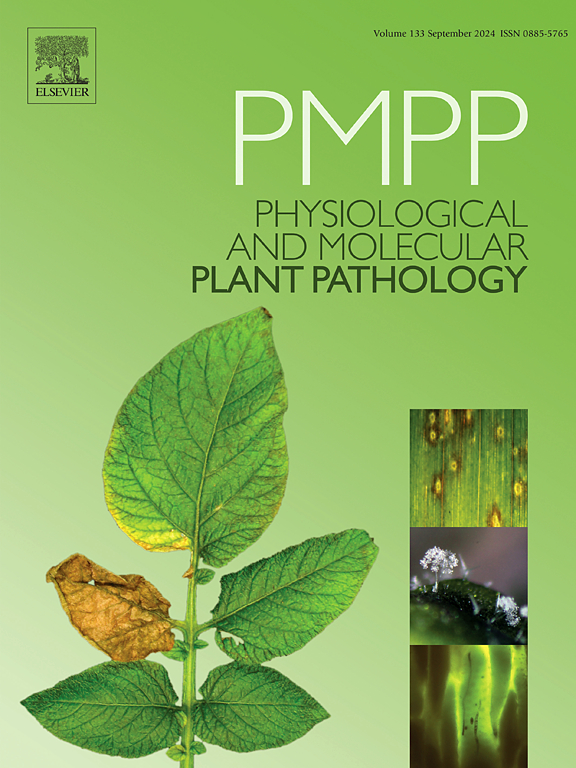Advancing soybean rust resistance: Strategies, mechanisms, and innovations in gene pyramiding
IF 2.8
3区 农林科学
Q2 PLANT SCIENCES
引用次数: 0
Abstract
Asian soybean rust (ASR), caused by the fungus Phakopsora pachyrhizi, is a devastating threat to global soybean production, with potential yield losses of over 80 %. The pathogen's ability to complete multiple infection cycles and its high genetic variability present significant challenges for management, as reliance on fungicides is both costly and increasingly undermined by the development of resistance issues. Genetic resistance, conferred by major resistance genes (Rpp1–Rpp7), offers a sustainable alternative, but the durability of this single-gene-mediated resistance is often lost by evolving pathogen populations. Gene pyramiding, the strategic stacking of multiple Rpp genes within a single cultivar through crossbreeding or DNA recombinant technology, has emerged as a sustainable solution to achieve enhanced resistance against diverse ASR isolates. Pyramiding or stacking of Rpp genes has been proven to increase the resistance level and enlarge the resistance spectrum against a complex ASR population. These multigene pyramided lines demonstrate greater durability of resistance than single Rpp lines, offering a prospective avenue for developing elite soybean cultivars against ASR. Many of these lines could be deployed to characterize pathotype differentiation of P. pachyrhizi with higher precision than differential varieties. However, several challenges, including incomplete transfer of key genetic elements, dominance effects among resistance genes, genotype × environment interactions, linkage drag, and the extended time required for breeding, complicate the implementation of gene pyramiding. Recent advancements in genomic tools, such as marker-assisted selection (MAS), genomic selection (GS), and next-generation genome editing, such as CRISPR/CAS, show potential to revolutionize the gene pyramiding process, improving precision and efficiency. This review synthesizes current progress in gene pyramiding strategies, highlights innovative tools for overcoming existing challenges, and explores future research directions to mitigate ASR's impact and promote sustainable soybean production worldwide.
推进大豆抗锈病:基因金字塔的策略、机制和创新
亚洲大豆锈病(ASR)是由真菌Phakopsora pachyrhizi引起的,对全球大豆生产构成毁灭性威胁,潜在产量损失超过80%。该病原体完成多个感染周期的能力及其高度遗传变异给管理带来了重大挑战,因为对杀菌剂的依赖既昂贵又日益受到耐药性问题的影响。由主要抗性基因(Rpp1-Rpp7)赋予的遗传抗性提供了一种可持续的选择,但这种单基因介导的抗性的持久性往往随着病原体种群的进化而丧失。基因金字塔,即通过杂交或DNA重组技术将多个Rpp基因战略性地堆叠在一个品种中,已成为增强对多种ASR分离株抗性的可持续解决方案。Rpp基因的金字塔或堆叠已被证明可以提高对复杂ASR群体的抗性水平和扩大抗性谱。这些多基因金字塔系表现出比单一Rpp系更强的抗逆性,为培育抗ASR的大豆优良品种提供了一条有前景的途径。其中许多品系可用于鉴定肿根菌的病型分化,其精确度高于鉴别品种。然而,一些挑战,包括关键遗传元件的不完全转移,抗性基因之间的优势效应,基因型与环境的相互作用,连锁阻力,以及育种所需的时间延长,使基因金字塔的实现变得复杂。基因组工具的最新进展,如标记辅助选择(MAS)、基因组选择(GS)和下一代基因组编辑,如CRISPR/CAS,显示出彻底改变基因金字塔过程的潜力,提高了精度和效率。本文综述了基因金字塔策略的最新进展,重点介绍了克服现有挑战的创新工具,并探讨了未来的研究方向,以减轻ASR的影响,促进全球大豆的可持续生产。
本文章由计算机程序翻译,如有差异,请以英文原文为准。
求助全文
约1分钟内获得全文
求助全文
来源期刊
CiteScore
4.30
自引率
7.40%
发文量
130
审稿时长
38 days
期刊介绍:
Physiological and Molecular Plant Pathology provides an International forum for original research papers, reviews, and commentaries on all aspects of the molecular biology, biochemistry, physiology, histology and cytology, genetics and evolution of plant-microbe interactions.
Papers on all kinds of infective pathogen, including viruses, prokaryotes, fungi, and nematodes, as well as mutualistic organisms such as Rhizobium and mycorrhyzal fungi, are acceptable as long as they have a bearing on the interaction between pathogen and plant.

 求助内容:
求助内容: 应助结果提醒方式:
应助结果提醒方式:


